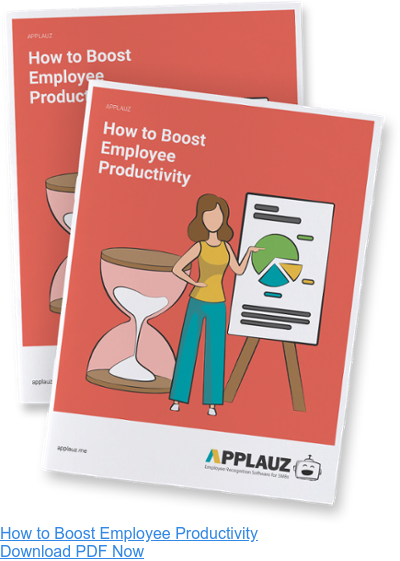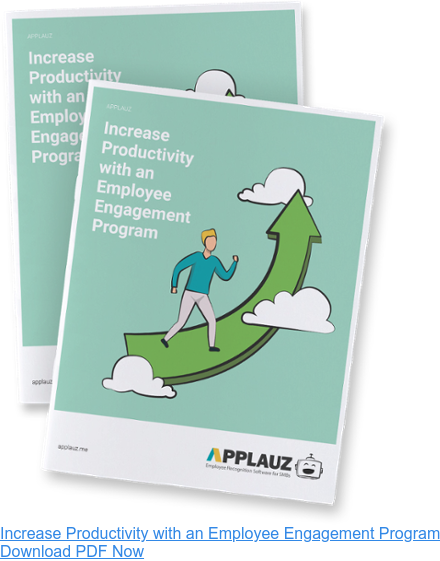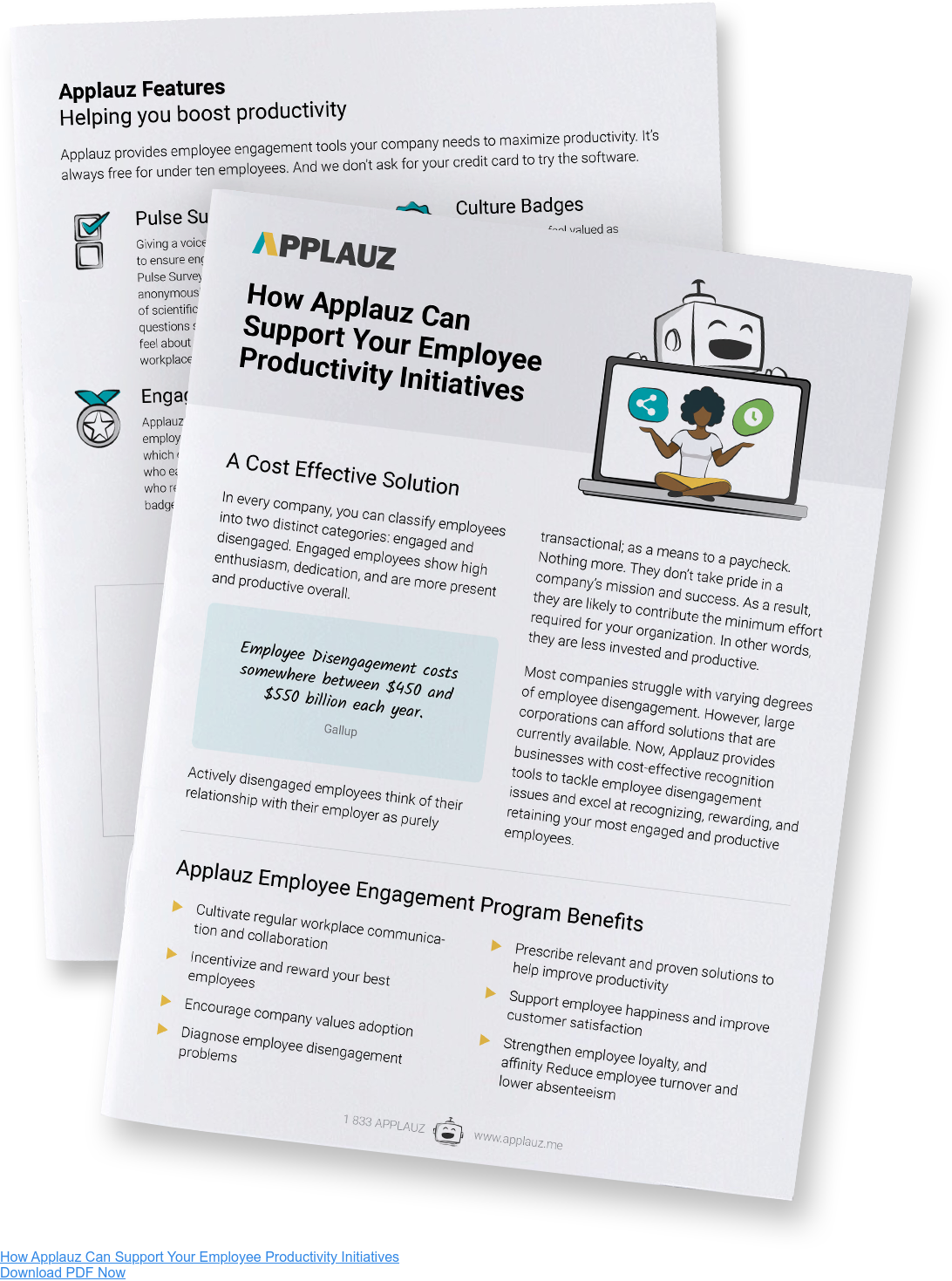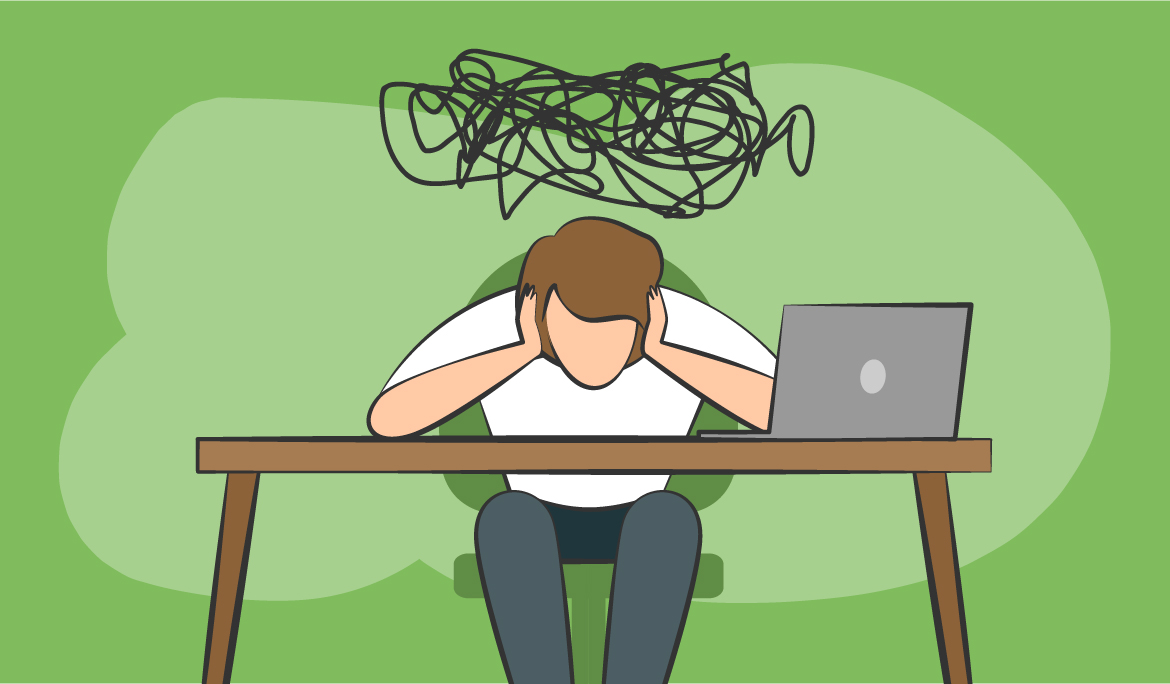 What Can Productivity Statistics Tell Us?
What Can Productivity Statistics Tell Us?
Picture this...it's 9 am on a Monday.
You have a hot cup of coffee and a meticulous to-do list by your side. You crack your knuckles and get ready to start the week off on the right foot.
 A few minutes into your day, and you're feeling great, ideas are naturally flowing, you think to yourself, "this is going to be my most productive day." Suddenly, you’re jolted out of focus by a DING! Social media notifications are coming in, and your phone begins to flash and vibrate.
A few minutes into your day, and you're feeling great, ideas are naturally flowing, you think to yourself, "this is going to be my most productive day." Suddenly, you’re jolted out of focus by a DING! Social media notifications are coming in, and your phone begins to flash and vibrate.
Your attention shifts away from your work and onto your flashing phone, you suddenly notice a group of coworkers standing near and loudly chatting over coffee — "Were they this noisy before?"
Then, your gaze quickly darts to your second screen, you notice a red badge pop up on your email app. These messages are probably not urgent; you're actively fighting the urge to check them, but it’s still a distraction. By now, your concentration is shattered. And before you know it, it's almost lunch, and you've only produced a fraction of what you intended to.
Distractions are everywhere
Humans can produce exceptional work when they are intentional, determined, and, most importantly — free of distraction.
The problem is distractions are inescapable in our tech-driven world.
You’ve probably had the experience of wanting to start an important task, only to find yourself deep in cat videos an hour later. Distractions fuel procrastination and are the opposite of productivity.
Faced with a compelling and instantaneous reward (like a hilarious cat video) exerting self-control and working hard for distant rewards often takes a back seat.
When it comes to fighting distractions, the primitive mind isn't on our side, especially when instant gratification requires so little effort.
Statistics on productivity in the work context support these assumptions. For example, a study by Hubspot found that office workers spend 28% of their day on unnecessary distractions. That's more than a quarter of the day!
Other studies suggest that people are spending only about half the workday on legitimately productive work. What are they doing with the other half of the day?
As you can imagine, these daily losses in productivity have a significant impact on a business's bottom line.
On the other hand, we can't expect humans to be as productive as machines either. So the question remains: Exactly how can a business maximize their human resources, all the while ensuring to treat and recognize their employees humanely and fairly?
Approaching the idea of productivity from a modern perspective is a good start, a concept we will explore in the next section. Also, being aware of both the internal and external barriers to productivity and maximizing productivity in a modern work setting becomes possible.
 Defining Employee Productivity: Input Vs. Output
Defining Employee Productivity: Input Vs. Output
Work is often conceptualized in a linear way. Meaning: the more hours one puts in, the more productive they are.
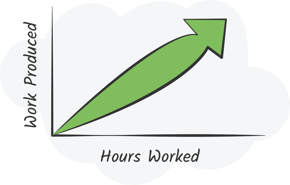 It's natural and intuitive to believe that work functions this way, and historically speaking, work and productivity have been approached from a linear perspective.
It's natural and intuitive to believe that work functions this way, and historically speaking, work and productivity have been approached from a linear perspective.
Today, we can appreciate a more refined and layered definition of productivity by looking at how the concept has evolved over the last several decades.
Productivity through time
Let's step into a time machine and travel back to a rougher and unforgiving industrial time when labour was abundant and cheap.
During this era, the ultimate goal was to maximize worker's productivity at all costs.
But, productivity was measured primarily by input; in short, the number of hours present at work. As a case in point, it was highly common to find industrial workers working 80-100 hour weeks during this time.
Again, industry owners assumed the more labourers worked, the more they would produce. However, this notion misses a crucial point: Humans are not machines. They get tired — mentally and physically. They can succumb to injuries, among other factors that slow workers down.
Then along came Henry Ford.
In 1926 Henry Ford popularized the 40-hour workweek after discovering that working excessive hours only yielded a small increase in productivity and only for a short period. Thank you, Mr. Ford.
The current reality
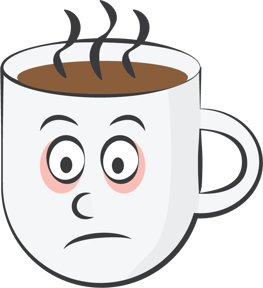 We now have labour norms and laws to protect workers from being exposed to such extreme working conditions.
We now have labour norms and laws to protect workers from being exposed to such extreme working conditions.
However, even within the 40-hour workweek, many companies still approach productivity from a linear perspective, focusing on input as an indicator of productivity.
For example, keeping close tabs on how early employees arrive, breaks, and how many late nights employees stay clock in.
But ask yourself this: Does scrutinizing an employee's schedule say anything about their output?
Think about this real-world example: Pulling an all-nighter to produce a paper at the last minute. Perhaps you ended up with multiple pages in a short amount of time — great, by all accounts, you were "productive." But how did that presentation or essay turn out? Would you call that your best work? Probably not.
With creative, high-value tasks, the relationship between the amount of time spent on a task and productivity is not always a straight, positive line. Simply put, more input (i.e. hours worked) doesn't always yield higher output — eventually, the law of diminishing returns kicks-in.
To illustrate this in action, just look at a recent experiment conducted by Microsoft Japan. The company rolled out a bold initiative to improve their workforce's work-life balance — a 4-day workweek.
What Microsoft Japan found when decreasing the number of hours worked in a week (and offering the same wage) the company's overall productivity soared by 40% to be exact!
Microsoft Japan discovered an idea similar to Henry Ford over 100-years ago: working more hours doesn't automatically mean an increase in productivity.
Although the industrial sector still exists, and a linear model of production sometimes applies, the total output shouldn't be the only measure of performance. For creative, tech, and many other industries, the value or quality of that output is just as significant; employee performance and productivity metrics should always reflect that.
Let's unpack this idea a little further...
How to measure productivity
In our modern work environment, the definition of productivity should take into consideration the value and quality of production as well. Setting your teams up for success means shifting focus on tracking employee output as well.
A traditional model of productivity is limited and doesn't give us a granular understanding of the total output of one's work.
In sum, a more fitting definition of productivity means producing valuable and quality work in a short amount of time.
In short: creating value — efficiently.
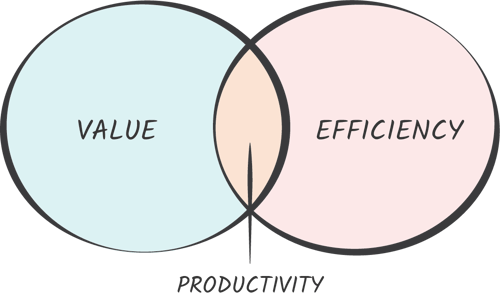
Now that we have a working definition of productivity, we can look at some common obstacles that prevent people from reaching maximum productivity potential.
 Factors Affecting Employee Productivity
Factors Affecting Employee Productivity
Hubspot conducted an analysis of a nationwide survey of more than 2,000 professionals and found interesting statistics regarding barriers to productivity in the workplace:
- 61% think loud colleagues are the biggest office distraction
- 89% prefer to work alone to hit maximum productivity
- 40% consider impromptu meetings from coworkers stopping by their workspace as a major distraction.
The modern-day office is rife with impediments to efficiency. For simplicity, they can be reduced to a few overarching themes.
Three main types of productivity obstacles:
1. Environmental
- Noise distractions
- Visual distractions
- Human distractions
2. Organizational
- Unrealistic goals
- Lack of flexibility
- Multitasking
- Unclear objectives & mission
- Missing/faulty tools
3. Psychological
- Lack of communication
- Lack of trust and respect
- Negativity
Categorizing the obstacles to productivity is important because it will allow you to quickly identify which category needs the most attention in your organization. Moreover, some categories are more manageable to treat than others.
That said, by further unpacking these obstacles to productivity, we can reduce them into two main categories: external and internal. Think of these, not as binary categories, but rather living on two ends of a continuum.

External barriers to productivity
Thinking back to the average workday scenario at the beginning of this article, you can easily paint a picture of what external barriers to productivity look like.
The average workday is filled with hundreds, if not thousands of these external micro distractions. These are often tangible (or audible) components of work such as noises, visual distractions, digital notifications, loud colleagues, and so on.
But external barriers to productivity don’t stop there. 
Other external barriers that are slightly less tangible exists, such as multitasking, missing or faulty tools, murky goals, and being overworked. These barriers result from poor organizational practices and expectation management.
The bad news: These barriers fuel procrastination and wreak havoc on an employee’s ability to get to work, focus, and concentrate.
The good news, however, is that these barriers to productivity are the most tangible and real, and therefore are easier to treat and minimize with proper intervention and control.
Internal barriers to productivity
To understand internal barriers to productivity, it helps to think about the following scenario.
A diligent and motivated employee feels their hard work is unrecognized in the day-to-day. Managers are stressed and overworked, and the organization overlooks regular open and honest communication. As a result, busy managers only make time for recognition during formal evaluations, a handful of times a year.
 This employee wishes for a genuine "thank you" or "good job" at the end of a long week. The weeks go by, and this employee continues to put in the same effort, but a lack of recognition continues. As the basic need for appreciation goes unmet, a slow decline towards detachment begins. Absenteeism usually follows. Until eventually, full disengagement occurs. Productivity ultimately suffers.
This employee wishes for a genuine "thank you" or "good job" at the end of a long week. The weeks go by, and this employee continues to put in the same effort, but a lack of recognition continues. As the basic need for appreciation goes unmet, a slow decline towards detachment begins. Absenteeism usually follows. Until eventually, full disengagement occurs. Productivity ultimately suffers.
Internal barriers to productivity, such as lack of communication and a need for autonomy and praise, pose a significant challenge as they are mostly invisible, and as a result, more difficult to identify, measure, and ultimately treat.
This is where an Employee Engagement Program comes in to dismantle psychological barriers to productivity by fostering an environment of continuous real-time feedback characterized by mutual respect, trust, appreciation, and, most importantly, recognition.
 How to Improve Employee Productivity
How to Improve Employee Productivity
A singular magic one-size-fits-all solution to maximum productivity doesn’t exist. Improving productivity takes the application of a wide variety of tried and true strategies, tips, and research-driven hacks.
Pro tip: Looking at your top performers and their productivity hacks can often help.
That said, a lack of productivity stems from many things: ranging from internal factors such as employees feeling unappreciated to external factors like a noisy office, and everywhere in between.
Many successful organizations have first-hand experience tackling this issue, and other businesses can benefit from their experiences. Let's have a look at the top strategies for improving employee productivity.
Limit interruptions & minimize distractions
Management can't erase all distractions, but they can certainly help to minimize them.
 To illustrate, let’s say that you’re a manager in an “open concept” workplace, you should let your employees know that if they want to have an extended chat with someone on the “floor”, they should go to the meeting room or lounge area, so as to not disrupt or distract the flow of others around them.
To illustrate, let’s say that you’re a manager in an “open concept” workplace, you should let your employees know that if they want to have an extended chat with someone on the “floor”, they should go to the meeting room or lounge area, so as to not disrupt or distract the flow of others around them.
And for employees who make or take calls often, create a designated area that is shut off from the rest of the group so the employee can make a call without disturbing everyone else.
Management must intervene to ensure the office environment is controlled. There should be designated areas set up for deep (and silent) focused work, spaces for collaboration, and finally, areas for free socializing. Ensuring that employees respectfully follow guidelines and utilize the space effectively, you can help minimize environmental distractions as much as possible and remove this very common barrier to productivity
Give regular recognition
When immediate rewards and instant gratifications are just an effortless click away, self-control and working hard for distant rewards usually take a back seat. As a result, distractions take over, and productivity suffers.
The lesson: Ensure clear rewards are always in sight. Don’t delay rewards or relegate praising employees to formal evaluations that happen only a few times a year. Do it often. Celebrating successes (big and small) should always be a top priority for managers.
A 2019 study conducted by Deloitte called “The Practical Magic Of Thank You” found that for their day-to-day work, employees appreciate a verbal and straightforward ‘thank you’ the most.
 The giving of consistent feedback and recognition can also be facilitated with the help of great employee recognition software like Applauz Recognition.
The giving of consistent feedback and recognition can also be facilitated with the help of great employee recognition software like Applauz Recognition.
Implementing an engagement and rewards program fosters an environment of trust and satisfaction, and workplaces that boast a positive atmosphere based on mutual respect and trust are shown to be more productive and profitable.
In addition to recognition and reward, organizational research suggests that taking vacations and breaks is necessary for maintaining mental energy levels and overall productivity.
So, on a final note, it’s important to — not only reward and acknowledge your employees — but encourage them to take time off and well-deserved breaks when they’ve worked hard. They will return to work feeling recharged, refreshed, and ready for another sprint of productivity.
Work in intervals & prioritize
If there’s no systematic way to approach work, employees easily fall into the trap of being unsure where to start and feeling overwhelmed — often resulting in intense anxiety.
At this point, inertia quickly follows. Ambiguous, unrealistic goals and a full plate of work can be downright paralyzing. Fueled by fear of failure, this anxious energy makes people vulnerable to temptations of the instant-gratification variety. Like pointless social media use, for example.
The antidote: Managers can help employees with efficiency by ensuring that goals are realistic, actionable, and organized in order of priority.
In short, goals that are broken down into more deliverable and manageable mini-tasks clear up the path to success, and work becomes less daunting as a result. In short, when employees feel supported and reassured, anxiety and pressure slowly subside, and the desire to indulge in procrastinating activities simultaneously diminishes.
 Monitoring Employee Productivity
Monitoring Employee Productivity
Whether you’re an HR or management professional, you’re probably overseeing and managing groups of educated adults, not children. Why then would you operate and monitor your team as if they were? Trust and productivity go hand in hand.
In short, when you show people through your words and behaviour that you have confidence and trust in them, they will likely feel flattered and autonomously fulfill your expectations.
When you give workers flexibility and ownership over their work and projects and hold them accountable, they will most often live up to that expectation and even surpass it. Because ultimately, people want to see themselves as the wheel. Not as a cog.
 Trust fuels productivity
Trust fuels productivity
Rigid management negatively impacts morale and engagement, and employees may succumb to a self-fulfilling prophecy. In short, if they feel like you can’t trust them, they will act and do untrustworthy things because you don’t trust them to begin with!
A 2015 Harvard Business Review report shows that trust helps employees feel less stressed and focus more intensely on their tasks without the constant fear of being fired, reprimanded, or ridiculed by peers.
When monitoring undermines productivity
When management operates from a place of skepticism and worry, its grip over employees will tighten. As a result, managers may monitor productivity closely, or impose screen monitoring software, block access to social media, or forbid employees to text or take personal calls during work. Although it may seem like a logical solution, tightening your grip over employees has been shown to erode morale and group trust.
Constantly monitoring employees to the point where they are practically being policed will undoubtedly affect motivation and undermining engagement and productivity as well. Even if your intentions are in the right place, heavily monitoring productivity through software often produces the opposite of the desired outcome. Instead, consider less intrusive approaches and monitor engagement instead of productivity. Pulse surveys are a perfect tool to understand the sentiment within your organization.
 Collaboration & Productivity Software
Collaboration & Productivity Software
Traditional methods of tracking work progress, productivity, and goals include excel sheets and good old fashioned to-do and priorities lists.
Now, a multitude of cloud-based applications and software exists to help maximize productivity and generate collaboration between teams.
Most popular software choices
These applications have the benefit of giving managers a 360-degree view of what their team is working on. So they’re always aware of who is working on what and when. These tools are essential to management today and help keep a team aligned on what needs to get done.
Not all tools and created equal though, some are designed for larger-scale teams and operations while others or better suited to small groups or even individual productivity tracking.
Software review site Capterra lists all the productivity apps in their database. You can sort through them either by highest rated or by most rated.
 Trello software
Trello software
Trello is a collaboration and project management tool for teams of all sizes. This app enables users to organize their tasks via boards, lists, cards, and other productivity tools.
It’s also fun to use and user-friendly. Trello offers various pricing plans for different sized teams and business needs, so it may be an attractive option for smaller or rapidly scaling teams.
 Asana software
Asana software
Asana is a robust project management tool and one of the most popular on the market. Larger scaled teams and businesses use it because of its many powerful features and integrations.
Although more expensive than Trello and Monday, Asana offers various pricing tiers for different sized teams. Even a free basic subscription is offered, as well.
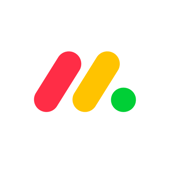 Monday software
Monday software
Monday software is known for its young and trendy eye-catching design and user experience. The platform facilitates project management and encourages the sharing of knowledge with users. Users can communicate and create a knowledge base through various features.
The stylish design and innovative features come at a price. Although Monday offers different pricing tiers, the starting price is higher than Trello but slightly less than Asana.
 Final Thoughts
Final Thoughts
Seeing human dynamics through a purely mechanical lens misses a crucial tenet of people management needed for positive outcomes. Humans are not specialized task robots or automated, unfeeling machines — quite the contrary! In the long-run, treating them as such is detrimental to overall employee engagement and in extension, productivity.
It may feel counter-intuitive, but the more rigid you are with your staff — placing constraints on them — the more productivity will suffer as a result. However, this isn’t to say you should let your employees run wild and free.
It means acknowledging your human labour is just that — human.
The key to maximizing overall contribution and output is finding a sweet spot where your organization stays knowledgeable and realistic about the limits of cognitive effort and attention while respecting and trusting employees as autonomous individuals.
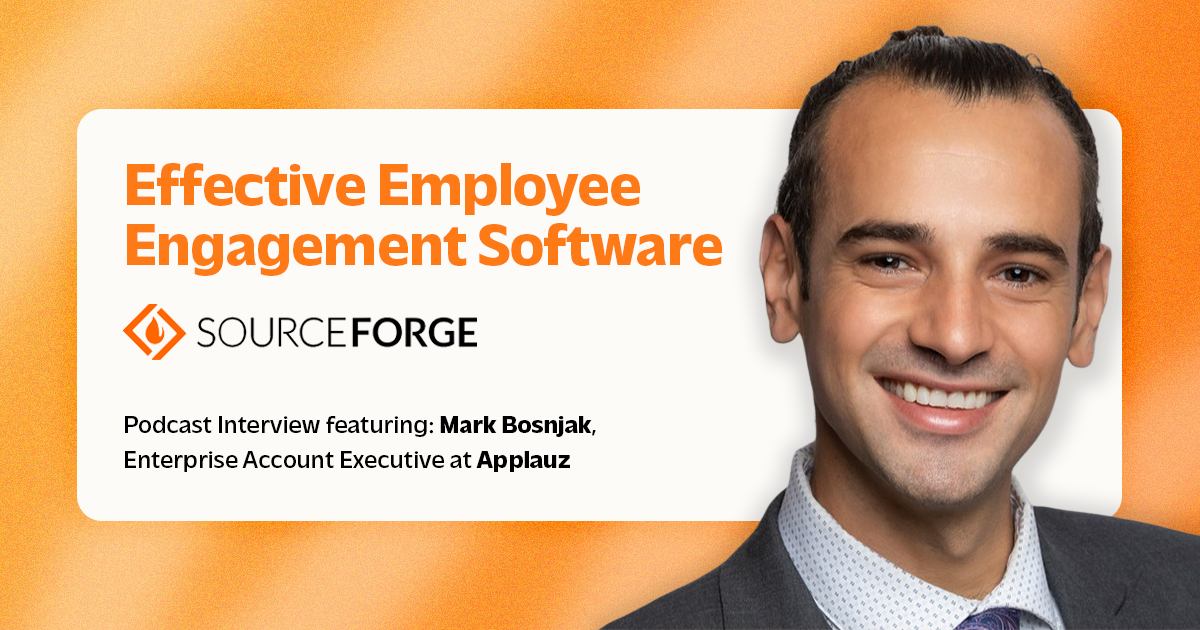 Applauz on SourceForge: Effective Employee Engagement Software
Applauz on SourceForge: Effective Employee Engagement Software

